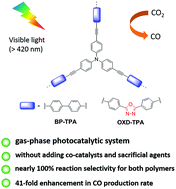Triphenylamine based conjugated microporous polymers for selective photoreduction of CO2 to CO under visible light†
Abstract
Organic π-conjugated polymers (CPs) have been intensively explored for a variety of critical photocatalytic applications in the past few years. Nevertheless, CPs for efficient CO2 photoreduction have been rarely reported, which is mainly due to the lack of suitable polymers with sufficient solar light harvesting ability, appropriate energy level alignment and good activity and selectivity in multi-electron-transfer photoreduction of CO2 reaction. We report here the rational design and synthesis of two novel triphenylamine (TPA) based conjugated microporous polymers (CMPs), which can efficiently catalyze the reduction of CO2 to CO using water vapor as an electron donor under ambient conditions without adding any co-catalyst. Nearly 100% selectivity and a high CO production rate of 37.15 μmol h−1 g−1 are obtained for OXD-TPA, which is significantly better than that for BP-TPA (0.9 μmol h−1 g−1) as a result of co-monomer change from biphenyl to 2,5-diphenyl-1,3,4-oxadiazole. This difference could be mainly ascribed to the synergistic effect of a decreased optical band gap, improved interface charge transfer and increased CO2 uptake for OXD-TPA. This contribution is expected to spur further interest in the rational design of porous conjugated polymers for CO2 photoreduction.

- This article is part of the themed collection: Celebrating our 2021 Prizewinners


 Please wait while we load your content...
Please wait while we load your content...